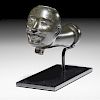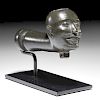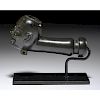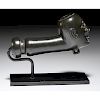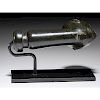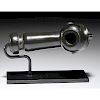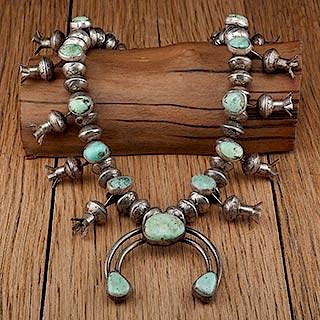An Exceptional Metis Figural Pipe, Thought to Represent Louis Riel (1844-1885)
About Seller
6270 Este Ave.
Cincinnati , OH 45232
United States
With offices in Cincinnati, Cleveland and Denver, Cowan’s holds over 40 auctions each year, with annual sales exceeding $16M. We reach buyers around the globe, and take pride in our reputation for integrity, customer service and great results. A full-service house, Cowan’s Auctions specializes in Am...Read more
Two ways to bid:
- Leave a max absentee bid and the platform will bid on your behalf up to your maximum bid during the live auction.
- Bid live during the auction and your bids will be submitted real-time to the auctioneer.
Bid Increments
| Price | Bid Increment |
|---|---|
| $0 | $25 |
| $500 | $50 |
| $1,000 | $100 |
| $2,000 | $250 |
| $5,000 | $500 |
| $10,000 | $1,000 |
| $20,000 | $2,500 |
| $50,000 | $5,000 |
| $100,000 | $10,000 |
About Auction
Apr 8, 2017 - Apr 9, 2017
Cowan's Auctions dawnie@cowans.com
- Lot Description
Height 2.5 in. x width 1.75 in. x length 5 in. The pipe is finely carved of a dense black slate or similar stone, the bowl a realistic human face sporting a wavy mustache and goatee, with detailed eyes and ears, the stem terminating in an elaborately carved fitting with various bands and raised circles. A perforated tab is present just behind the chin of the figure.
The face carved on the bowl is thought to be that of Louis Riel (1844-1885), a Metis spokesman, teacher, and leader of the Red River and North-West Rebellions of 1869 and 1885. Riel remains one of the most controversial figures in Canadian history. To the Metis he is regarded as a hero and defender of their native rights; in the Canadian west in 1885 most settlers saw him as a villain. Today he is viewed as the founder of the movements that protested central Canadian political and economic power (Hallpenny, 1983).
This pipe, with its grinning mustachioed visage, depicts an enigmatic non-Native figure that is known from at least three other pipes. Coe (1977: figure 166) and Ewers (1986:63) illustrate a nearly identical pipe curated in the British Museum that was sent by a W.A. Boyd from Pembina, Red River, Dakota Territory, to William Bragge a British pipe collector in December, 1868 (Bragge Collection, Catalog D.C. 39.). The sole difference between the pipe offered here and its mate in the British Museum lies in the facial hair carved on the face; the pipe here has a mustache and chin whiskers, the pipe collected by Boyd sports bushy mutton chops. Beyond this detail, the pipes are identical, and were almost certainly carved by the same hand.
The British Museum (Christy Collection, St723) also curates a black stone pipe featuring a long stem and bowl carved with at least three faces, employing many of the same features as the pipe in this lot (Coe 1977:167). Collection records indicate the pipe was acquired by Henry Christy sometime between 1860-69.
Sotheby's offered a similar three-faced pipe in their November, 1995 auction of American Indian Art (Sale 6783, Lot 107), featuring the same mustachioed, grinning face. This example had the name William carved into the stem.
Both the style, stone, and facial characteristics employed on these pipes suggests that all were probably made by the same craftsman, and some may feature the same individual. The Bragge Collection pipe, sent to London from Pembina, Dakota Territory in 1868, provides a geographic locus for their production, as well as a clue as to the characters they may represent.
Following the passage of the Rupert’s Land Act of 1868, the Canadian government agreed to purchase Rupert’s Land – a vast tract encompassing the entire drainage of Hudson’s Bay -- from the Hudson Bay Company. In advance of the purchase, the Canadian minister of public works, William McDougall ordered a survey party to the Canadian portion of the Red River Colony, a tract of land straddling what is today parts of North Dakota, Minnesota and southern Manitoba.
McDougall, an Anglophone and Protestant, was disdainful of the local Catholic, French speaking Metis population, who refused to recognize his authority. Warned by Hudson Bay Governor William Mactavish that such incursions would likely generate unrest, McDougall persisted. When a government party arrived at the Hudson Bay post of Fort Garry (Winnipeg) in the fall of 1869, they were met with resistance from a provisional Red River Colony government led by Louis Riel, a formally educated local Metis. In early October, Riel’s supporters organized “The Metis National Committee” and a few weeks later turned back McDougall’s survey party near the United States border, forcing them to retreat to Pembina, Dakota Territory. On the same day, Riel’s followers seized control of Fort Garry.
In the months that followed, Riel became the leader of a provisional government, and entered into direct negotiations with Canada, presenting a list of 14 rights as a condition of union. Unrest continued, with a contingent of Anglophones determined to depose the Metis government, culminating in the execution of Thomas Scott, a member of the opposition. Finally, in May, 1870, the Province of Manitoba was admitted into the Canadian confederation.
When a contingency of troops under Canadian authority arrived at Fort Garry, Riel and his followers fled. Despite negotiations with the Canadian Govvernment, was Riel was exiled from Canada for five years, and eventually settled in Montana where he continued to espouse the rights of the Metis. He returned to Manitoba in 1885 to lead the ill-fated North-West Rebellion. Captured, tried and convicted of high treason, he was executed
Photographs and lithographs of Riel at the time of the Red River Rebellion in the late 1860s show him sporting a bushy mustache, and given his popularity among the Metis, it would hardly be surprising that an enterprising pipe maker employed his face as a symbol of solidarity. In addition, the three-faced pipe sold at Sotheby’s in 1995 employed the word “William” on the stem, perhaps in reference to either the despised William McDougall, or William Mactavish the original Governor of Rupert’s Land.
References cited:
Ralph Coe. 1977Sacred Circles. Nelson Atkins Gallery of Art. Kansas City, Missouri
John Ewers. 1986 Plains Indian Sculpture. Smithsonian Institution Press.
Francess Halpenny 1983. Dictionary of Canadian Biography. University of Toronto Press. Volume XI (1881-1890). Extracted from the online version, www.biographi.ca/en/results.php/?ft=rielReferences to Online Museum Collections:
The Bragge Collection pipe curated at the British Museum: http://www.britishmuseum.org/research/collection_online/collection_object_details.aspx?objectId=534441&partId=1&searchText=pembina+pipe&page=1
The Christy Collection pipe curated at the British Museum: http://www.britishmuseum.org/research/collection_online/collection_object_details.aspx?bjectId=536402&partId=1&searchText=ojibwa+pipe&page=1
The Christy Collection pipe curated at the British Museum: http://www.britishmuseum.org/research/collection_online/collection_object_details.aspx?bjectId=536402&partId=1&searchText=ojibwa+pipe&page=1
- Shipping Info
-
SHIPPING. At the request of the buyer, Cowan's will authorize the shipment of purchased items. Shipments usually occur within two weeks after payment has been received. Shipment is generally made via UPS Ground service. Unless buyer gives special instructions, the shipping method shall be at the sole discretion of Cowan's Auctions, Inc.. Cowan's is in no way responsible for the acts or omissions of independent handlers, packers or shippers of purchased items or for any loss, damage or delay from the packing or shipping of any property.
-
- Buyer's Premium



 EUR
EUR CAD
CAD AUD
AUD GBP
GBP MXN
MXN HKD
HKD CNY
CNY MYR
MYR SEK
SEK SGD
SGD CHF
CHF THB
THB
